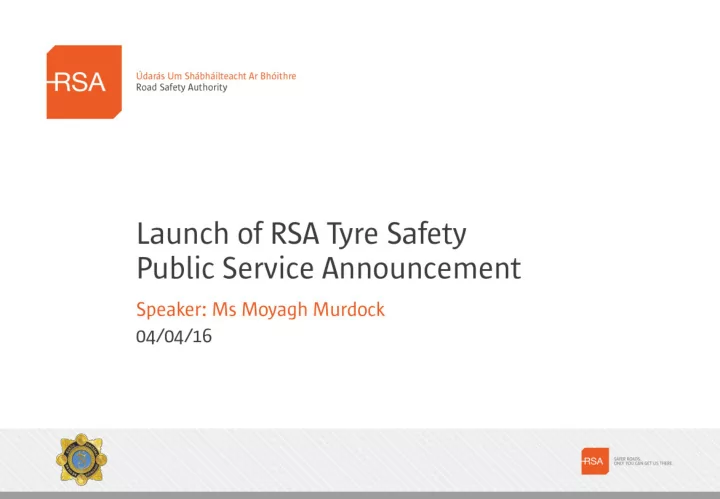

Where are we now? • In 2015, we had 166 deaths on our roads. • The Government Road Safety Strategy target is a reduction of road collision fatalities on Irish roads to 25 per million population or less by 2020 to close the gap between Ireland and the safest countries. • This means reducing deaths from 166 in 2015 to 124 or fewer by 2020. • A provisional target for the reduction of serious injuries by 30% from 472 in 2011 to 330 or fewer by 2020.
• As a result of collaborative approach with An Garda Síochána, significant changes have been made to the method of transfer of collision records to the RSA. • This upgrade enables a daily electronic transfer of a more extensive data set than previously received based on the updated CT68. • This will have significant positive impact on the reporting ability and subsequent response in terms of interventions and campaigns. • Access to forensic investigation files has significantly improved insights into the circumstances and causes of fatal collisions. • The research we are presenting today comes directly as a result of an analysis of the forensic collision files produced by An Garda Síochána. • The ‘Pre - Crash Report on Vehicle Factors in Fatal Collisions’ is the first in a series of pre-crash themed reports that the RSA will be publishing in conjunction with An Garda Síochána.
• Each driver has a legal responsibility to ensure that the vehicle they are driving is in a roadworthy condition. • This means conducting regular walk around checks on the vehicle before a journey to spot obvious issues like defective lights, worn tyres and worn windscreen wipers. • It also means ensuring your vehicle is serviced regularly by a qualified mechanic. For most cars, this should be at least twice a year, with one a general health check and one a more detailed check. • Older vehicles with worn components and those doing higher mileage need even more frequent servicing to be kept roadworthy.
• Evidence shows vehicles with higher safety ratings not only reduce the likelihood of collisions occurring but also reduce the severity of injuries in the event of a collision. • The NCT and Commercial Vehicle Roadworthiness Test (CVRT), check periodically whether vehicles on our roads meets basic requirements. • Yet every year approximately 50% of cars and heavy commercial vehicles fail to meet this very basic standard, many on key safety items. Similarly, 43% of light commercial vehicles fail the test. • Tyre condition is one of the most common items on which vehicles fail the test.
NCT: top reasons for failing test in 2015 Front Brake Headlamp aim Tyre condition Stop lamps suspension lines/hoses 83,635 79,395 73,849 105,872 85,907
Examples of Tyre Damage/Wear Sidewall Tear Sidewall Cut Bulge Exposed Plies Penetration Damage
Commercial Vehicle checks and tyres: For Heavy Commercial Vehicles – buses, trucks and trailers – defective tyres are the 9 th most • common component to fail the annual roadworthiness test. • Defective tyres are also the most common defect found in roadside inspections of heavy commercial vehicles conducted by the Road Safety Authority with An Garda Síochána. For Light Commercial Vehicles, defective tyres are the 4 th most common component to fail the • test.
• A drivers safety, along with the safety of passengers and other road users, could depend directly on the condition of a vehicle’s tyres. • When purchasing tyres, invest in good quality tyres that are e-marked. • The RSA would urge people not to purchase used tyres, you just can’t be sure of their history and will cost you more in the long run. Example: A part worn tyre costing € 30 has tread thickness of 3.6mm. Therefore, it has 2mm of useable tread before it reaches the minimum legal tread depth of 1.6mm. This works outs at € 15 per mm of usable tread. On the other hand, a new tyre costing € 80 has 8mm of tread. Therefore, it has 6.4mm of useable tread before it reaches the minimum legal tread depth of 1.6mm. This works out at € 12.50 per mm of useable tread, and therefore offers better value. In addition to the increased costs in this example, you would have to buy three sets of these part worn tyres in order to get the same life as one new set of tyres. • Tyres are the part of your car that is most likely to put you at risk of a fatal collision if they’re not roadworthy. • The only contact between the vehicle and the road is the tyre.
• Recent B&A research (2015) carried out on behalf of the RSA showed 53% of motorists have experienced problems with their tyres in past 5 years – (33% ‘while driving’) • The ‘while driving’ problems are more prominent among younger drivers • The research we have undertaken which you will hear today specifically shows the quality of tyres plays a much bigger role in fatal collisions than previously thought
Recommend
More recommend